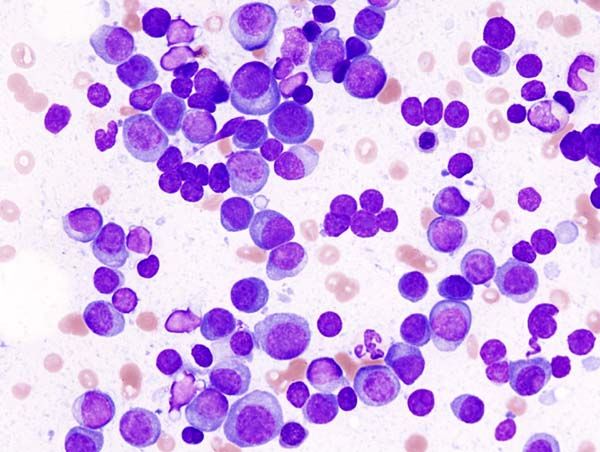Antiemetic Regimen Limits Chemo-Induced Nausea/Vomiting in Multiple Myeloma
Patients with multiple myeloma who received palonosetron, dexamethasone, aprepitant, and olanzapine achieved a 44.1% CR rate across all study phases.
Patients with multiple myeloma who received palonosetron, dexamethasone, aprepitant, and olanzapine achieved a 44.1% CR rate across all study phases.

Combination treatment with palonosetron (Aloxi), dexamethasone, aprepitant, and olanzapine (Zyprexa) demonstrated the capability to improve the antiemetic effect on delayed chemotherapy-induced nausea and vomiting while maintaining safety in patients with multiple myeloma receiving high-dose melphalan (Alkeran) and autologous stem cell transplantation (ASCT), according to results from a retrospective study published in Supportive Care in Cancer.
The phases of treatment were defined as follows: the observation period on days 1 to 7, the acute phase on day 1 of melphalan administration, the delayed phase on days 2 to 5, and the beyond-delayed phase on days 6 to 7.
The complete response (CR) rate in the delayed phase was 52.9% in patients who received the experimental regimen vs 31.4% in patients who received the standard regimen consisting of palonosetron, dexamethasone, and aprepitant (P < .05). During the acute phase, no significant CR rate differences were observed between the 2 groups, with 94.1% vs 90.7%, respectively; in the beyond-delayed phase, the experimental regimen achieved a CR rate of 61.8% vs 31.4% with the standard regimen (P < .001). Overall, the CR rate was higher in the experimental group vs the standard group, with CR rates of 44.1% and 25.9%, respectively (P = .038).
A multivariate analysis showed that age was associated with the CR rate in the acute phase (adjusted OR, 1.07; 95% CI, 1.00-1.15; P = .049). In the delayed phase, the experimental regimen was associated with the CR rate (adjusted OR, 2.34; 95% CI, 1.10-5.00; P = .028). In the beyond-delayed phase, the experimental regimen (adjusted OR, 3.42; 95% CI, 1.58-7.42; P = .002) and creatinine clearance (adjusted OR, 1.01; 95% CI, 1.02-1.03; P = .042) were associated with the CR rate. And in all phases, sex (adjusted OR, 2.88; 95% CI, 1.26-6.57; P = .012) was associated with the CR rate.
The incidence of grade 3 nausea was assessed via the percentage of patients who were treated with total parenteral nutrition, which was initiated at the physician’s discretion. In the observation period, no decreases in food intake due to stomatitis, sore throat, or dysphagia were reported; in the acute phase, no cases of nausea were reported; in the delayed phase, nausea occurred in 44.1% of the experimental group vs 75.9% of the standard group (P < .001); and in the beyond-delayed phase, nausea occurred in 66.2% vs 90.7%, respectively (P < .001).
“[Chemotherapy-induced nausea and vomiting] continue to pose a major challenge for [patients with multiple myeloma] undergoing [melphalan]/ASCT,” wrote lead study author Junpei Kato, of the Department of Pharmacy at Japanese Red Cross Medical Center in Tokyo, Japan, and Graduate School of Pharmaceutical Sciences at Chiba University in Japan, and coauthors. “Our findings indicate that the 4-drug intensive regimen including [olanzapine] may improve the antiemetic effect on delayed and beyond-delayed [chemotherapy-induced nausea and vomiting] while also ensuring safety in Japanese [patients with multiple myeloma] undergoing [melphalan]/ASCT.”
This study enrolled a total of 122 patients with multiple myeloma who underwent treatment with 200 mg of intravenous melphalan on day 1 and ASCT on day 3 at the Japanese Red Cross Medical Center between July 2020 and March 2024. Of these patients, 68 patients received the experimental regimen (0.75 mg of intravenous palonosetron on day 1, 9.9 mg of intravenous dexamethasone on day 1 and 6.6 mg on day 2, 125 mg of oral aprepitant on day 1 and 80 mg from days 2 to 5, and 5 mg of oral olanzapine on days 1 to 5) and 54 patients received the standard treatment (0.75 mg of intravenous palonosetron on day 1, 6.6 mg of intravenous dexamethasone on day 1, and 125 mg of oral aprepitant on day 1 and 80 mg on days 2 and 3).
Patients who experienced nausea and vomiting within 12 hours of starting high-dose melphalan, used antiemetic drugs within 24 hours of starting melphalan, developed complications with gastrointestinal symptoms during the observation period, and had preexisting type 2 diabetes and could not receive olanzapine were not included in the trial.
The primary end point of the trial was the CR rate during the delayed phase. Secondary end points included the CR rate during all other phases, the identification of factors associated with the CR rate, the incidence of grade 3 nausea, and the overall incidence of treatment-related adverse events (AEs).
The most common any-grade AE was diarrhea, occurring in 74.0% of the experimental group and 72.2% of the standard group; grade 3 or higher diarrhea occurred in 2.9% vs 14.8%, respectively (P = .022). Any-grade constipation occurred in 43.0% vs 22.2% (P = .018), and any-grade hiccup occurred in 57.3% vs 11.1% (P < .001). No grade 4 AEs or events that led to treatment discontinuation were observed.
Reference
Kato J, Uchida M, Ishikawa M, et al. Efficacy of intensive antiemetic therapy including olanzapine in multiple myeloma patients treated with high-dose melphalan with autologous stem cell transplantation. Support Care Cancer. 2025;33(9):777. doi:10.1007/s00520-025-09839-2
Navigating AE Management for Cellular Therapy Across Hematologic Cancers
A panel of clinical pharmacists discussed strategies for mitigating toxicities across different multiple myeloma, lymphoma, and leukemia populations.